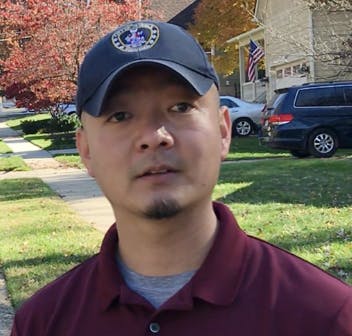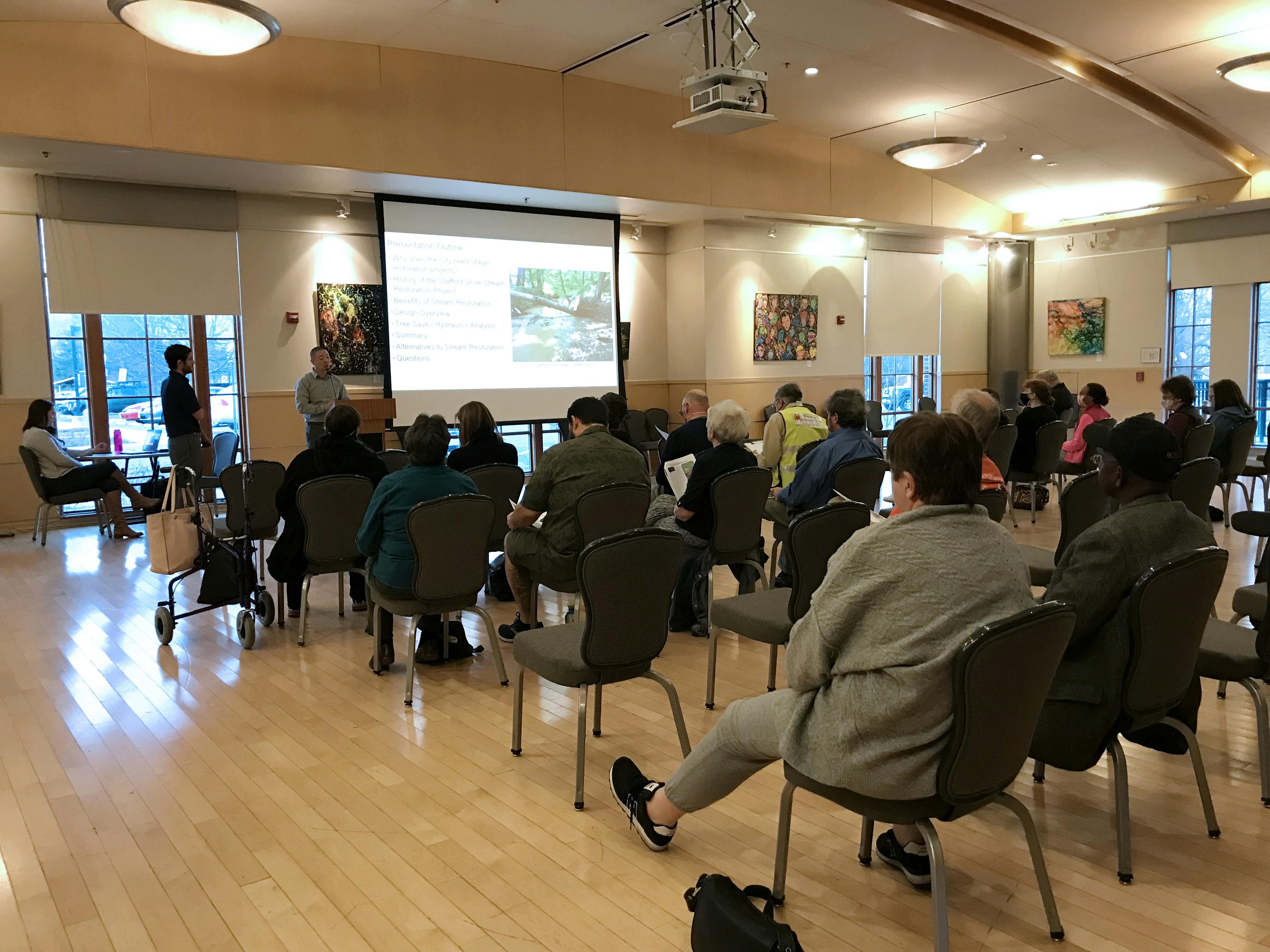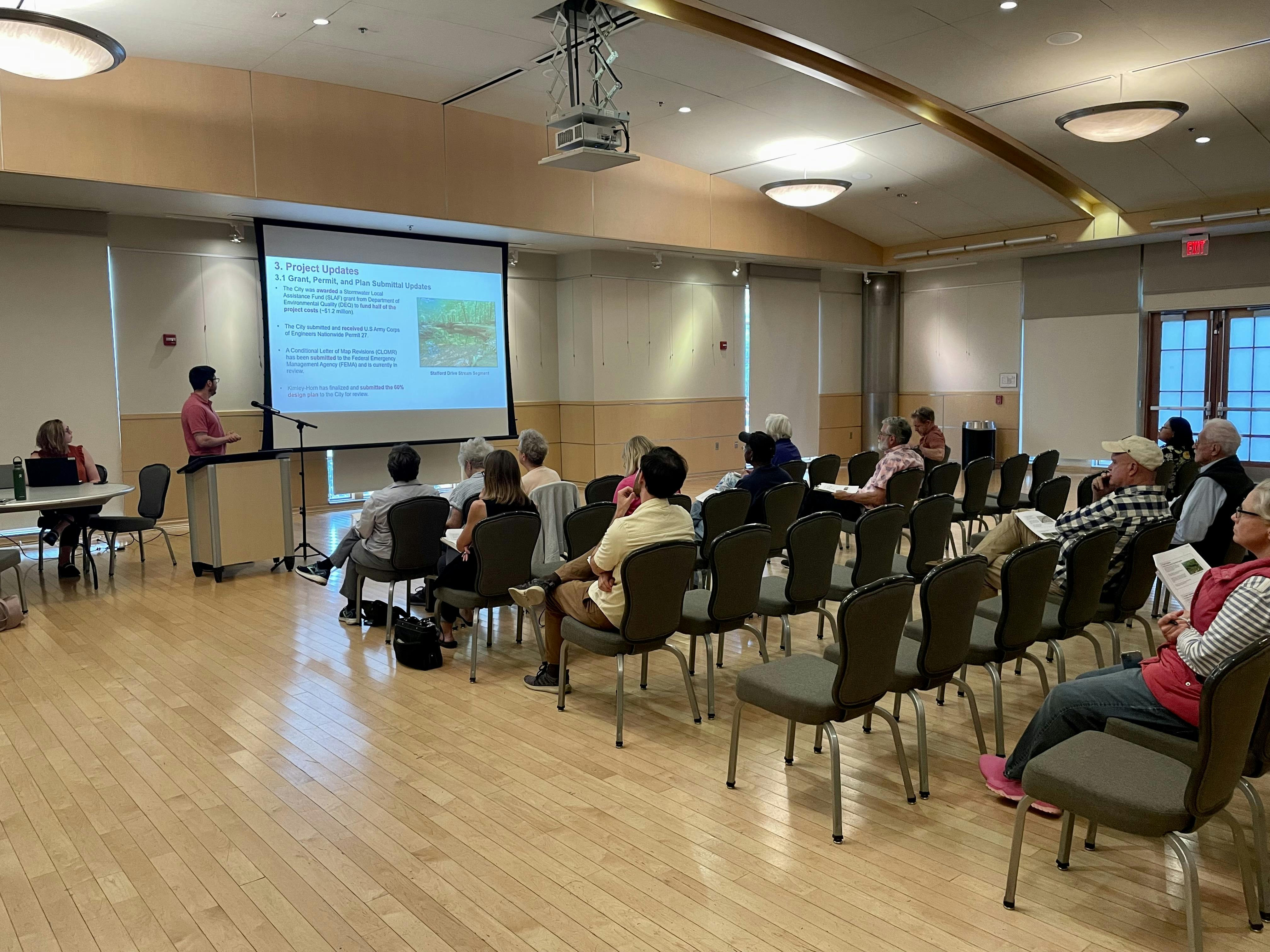Stafford Drive Stream Restoration
Dec. 9, 2025, UPDATE: The city began replanting the Stafford Drive stream restoration site on Dec. 8. Plantings include 2,800 trees and 6,650 shrubs. Streambanks will be fortified with 8,600 live stakes. Several super clumps will be installed. Super clumps are concentrated areas of plantings designed to discourage animal grazing, increase survivability, and establish dense vegetative cover faster. Planting is expected to be completed by January.
Work on the rest of the project is proceeding on schedule. Nearly all the stream restoration work is complete, and crews are now restoring the one remaining outfall channel near Fair Woods Parkway and grading the upstream end of the site.
 New plantings will anchor the soil, filter stormwater, and provide wildlife habitat.
New plantings will anchor the soil, filter stormwater, and provide wildlife habitat.###
Oct. 15, 2025, UPDATE: Construction of the lower third of the stream restoration project between Stafford Drive and Cardinal Road park is complete. Landscaping has not been installed yet; planting is scheduled for November. Construction of the retaining wall on the north side of the stream adjacent to the Mosby Woods condominium community is also complete. This wall allowed a grove of trees to be saved which provides screening for part of the community.
 Stream segment between Stafford Drive and Fair Woods Parkway
Stream segment between Stafford Drive and Fair Woods Parkway###
May 9, 2025, UPDATE: Earthwork has started on all sections of the pond, and the stream corridor is being lowered to reconnect the stream to the floodplain. Lowering the floodplain requires excavation, and crews have been hauling excavated material off site. The plunge pool downstream of Stafford Drive is complete, and this rock pool helps to dissipate energy from stormwater flowing through the culvert underneath the road. One of the two outfall channels at Fair Woods Parkway is complete. A series of rock step pools will allow stormwater to flow down this steep embankment without eroding it.



###
March 5, 2025, UPDATE: Crews have established access points to the stream restoration project from Fair Woods Parkway, Stafford Drive, and the Cambridge Station Association community park. Tree removal has been the primary focus, and this work will continue through March. We are installing a temporary mulch access path with timber bridges for construction equipment to cross the creek. Erosion and sediment controls are being installed as well.
###
Feb. 4, 2025, UPDATE: The project engineer, contractor, and staff, including the city’s urban forester, walked the perimeter of the entire Stafford Drive stream restoration project site and identified approximately 40 additional trees that can be saved.
The additional trees to be saved were selected based on collaborative discussion that included minor field changes to the design, anticipated impacts to the tree’s root zones, and health and species of the existing trees. These 40 trees are in addition to the 42 trees saved by adding a retaining wall to minimize grading and tree loss along the Mosby Woods condominium community.
###
Feb. 3, 2025, UPDATE: Fairfax City Council awarded a construction contract to Meadville Land Services in November 2024. Construction will start in mid-February.
###
The Stafford Drive stream restoration project area will be closed to the public for the duration of construction, which will take approximately 12 months.
The north fork of Accotink Creek between Plantation Parkway and Ranger Road Park, known locally as the Stafford Drive stream, is in bad shape. Over the years, fast-flowing stormwater has scoured the stream bed away and incised the streambanks, creating steep cliffs that prevent water from reaching the floodplain. Healthy, mature trees are collapsing into the stream due to severe erosion, and sediment washed downstream is burying aquatic habitat.
Many common questions about stream restoration are answered in our FAQ.
This project will restore nearly a half mile of the Stafford Drive stream. Natural Channel Design principles will be used to stabilize the stream to prevent further erosion and reconnect the stream to the floodplain. Natural materials incorporated in the design, such as rocks and logs, will slow down rushing stormwater. A natural meander, a feature of stable streams, will be created throughout the stream valley.
A preliminary design has been completed and we have developed a design that saves as many trees as possible within the project area.

Background
The Stafford Drive stream was identified as a high priority for restoration in the 2007 Accotink Creek Stream Stability Assessment. The $2.3 million project was approved in the FY21 budget and included in the FY2022-26 Capital Improvement Program. The design is 60% complete. A Stormwater Local Assistance Fund (SLAF) grant application was submitted in October 2021 to the Virginia Department of Environmental Quality. The city received notification in January 2022 that this project had been selected for SLAF grant funding, and $1,175,000 in matching state funding has been authorized for this project. The grant funds will cover half of the project’s estimated costs.
The city’s Chesapeake Bay Total Maximum Daily Load (TMDL) action plan is designed to reduce excess nutrients (nitrogen and phosphorus) and total suspended solids (loose sediment caused by erosion). Stormwater management projects like the Stafford Drive stream restoration help achieve these reduction targets.
Stream restoration projects repair years of unintentional abuse, restore ecological functions in the stream valley, create wildlife habitat, and improve water quality.
Supporting documents are available on this page.
- View the presentation from the Dec. 12, 2023, city council work session. (Start at 2:28:55.)
- View the presentation from the May 11, 2023, meeting.
- The Stream Restoration Design Alternatives Memoincludes:
- Pros/cons of design options. Design option 1 was selected following discussion with the Parks and Recreation Advisory Board. This option was viewed as a balance between saving trees and the impacts to hydraulics, construction costs, and future maintenance costs.
- Appendix B (pages 13-16) shows the trees saved by the three design alternatives that were considered. Design option 1 saves 42 trees.
- Appendix D (pages 33-48) provides the tree inventory, identification of existing dead/dying/diseased trees, and a table with the species/size/condition of each tree.
- View NVRC's stream restoration handout to learn how and why municipalities restore streams.
Ask A Question
The project manager will answer your questions.











